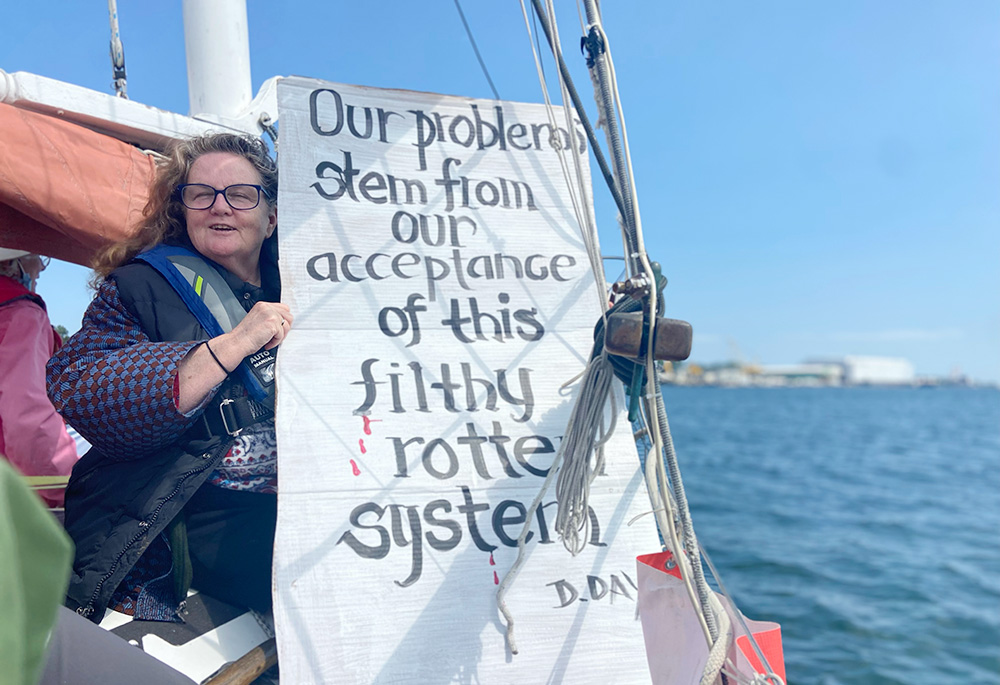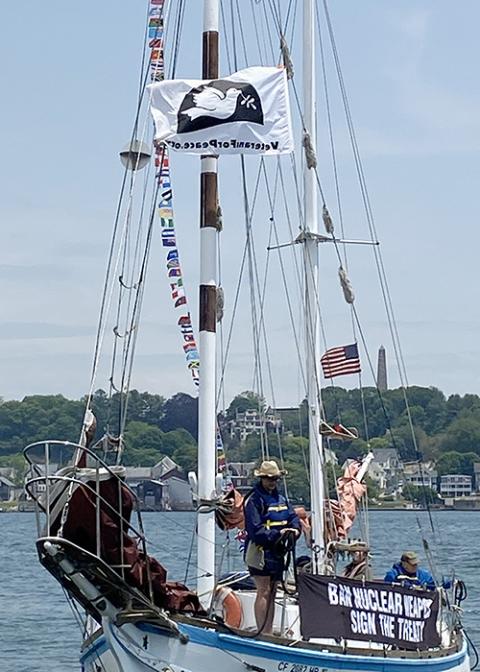
The Golden Rule docked at City Pier in New London, Connecticut, prior to a sail on June 9. (Michael Centore)The Golden Rule docked at City Pier in New London, Connecticut, prior to a sail on June 9. (Michael Centore)
Jacqueline Allen-Douçot, cofounder of the Hartford Catholic Worker in Hartford, Connecticut, has been organizing resistance to General Dynamics Electric Boat for more than 30 years. The company is the nation's largest supplier of nuclear submarines to the U.S. Navy. Its offices and fabrication facilities are located in New London, Connecticut, 45 miles southeast of Hartford.
"The Catholic Worker has been trying to make connections between money for the Navy and the lack of human resources," Allen-Douçot told me after dinner at St. James Episcopal Church in New London on June 9. We were gathered with other members of the CT Committee for the Prohibition of Nuclear Weapons, a loose affiliation of local groups united in their work for nuclear abolition.
Earlier in the day, the CT Committee had organized sails on the Golden Rule, considered the world's first modern protest ship. In 1958, its four-man crew was arrested in Honolulu when they tried to sail toward the Marshall Islands to demonstrate against nuclear weapons testing. Between 1946 and 1958, the U.S. had conducted 67 nuclear weapons tests in the islands, exposing Marshallese communities to dangerously high levels of fallout and radiation.
The action of the Golden Rule drew international attention and helped inspire the Limited Test Ban Treaty of 1963.
The Golden Rule was sold after its initial voyage, but resurfaced half a century later in Humboldt Bay in Northern California. Volunteers went to work restoring the boat, and in 2015 it was relaunched on a three-year tour up and down the West Coast as a project of the antiwar group Veterans for Peace.
Advertisement
The Golden Rule began its current journey in Minneapolis in September 2022, with a plan to follow the "Great Loop" of waterways around the eastern half of the United States. Its stop in New London was part of this 11,000-mile itinerary, which is expected to conclude in Chicago in September this year.
"The Golden Rule is sailing not just against nuclear weapons, but for a nuclear-free world," project manager Helen Jaccard explained. "The bylaws of the Golden Rule were written after the Fukushima [Japan] nuclear disaster in 2011 and reflect a concern about nuclear energy."
Catholics and other faith-based groups have witnessed against nuclear proliferation for decades. In the 1950s, Dorothy Day and other Catholic Workers served multiple jail sentences for refusing to participate in civil air defense drills. The Catholic Worker joined with various pacifist groups in 1957 to form Non-Violent Action Against Nuclear Weapons, an original sponsor of the Golden Rule.
The Non-Violent Action Against Nuclear Weapons reorganized as the Committee for Non-Violent Action in 1958. One of its first actions was a demonstration against the Polaris submarines then being produced by General Dynamics Electric Boat.
"The real goal was to raise awareness of the terrible effects of nuclear weapons," said Joanne Sheehan, an anti-nuclear activist from Norwich, Connecticut.

Theresa Allen of the Hartford Catholic Worker in Hartford, Connecticut, holds a sign aboard the Golden Rule. (Courtesy of Jacqueline Allen-Douçot)
The CT Committee for the Prohibition of Nuclear Weapons is a spiritual descendent of the Committee for Non-Violent Action. Sheehan points out that the Committee for Non-Violent Action was once headquartered at the current site of the Voluntown Peace Trust in Voluntown, Connecticut. The Peace Trust is one of the four members of the CT Committee, along with the Hartford Catholic Worker, the War Resisters League, and St. Francis House, an intentional Christian community in New London that is informed by the Catholic Worker movement.
"We sensed there was discomfort when talking about nuclear weapons in the community," said New London resident Frida Berrigan, who participated in the series of "clarification of thought" meetings at St. Francis House that inspired formation of the CT Committee.
She stressed that compassion is at the heart of the group's mission, which she defined as being "consistently present and visible as people who are against nuclear weapons but not against the people employed at Electric Boat."
Berrigan said that there had been a "turnover of generations" after a surge of anti-nuclear activity from the 1960s through the 1980s. The Treaty for the Prohibition of Nuclear Weapons, the first legally binding international agreement to outlaw nuclear weapons, has been an "exciting tool" to bring younger people into the movement, she said.
That treaty went into effect in January 2021. Flags of each of the 68 countries that have ratified it to date festoon the Golden Rule in tribute. There is mounting pressure from states and cities for the U.S. to adopt the treaty as well.

The Golden Rule returns from a sail on the Thames River in New London, Connecticut, on June 9. (Michael Centore)
Another way that groups are raising awareness is to point to nuclear abolition as an intersectional issue.
"Militarism and climate change are linked," Jaccard said. "The U.S. military is the largest emitter of CO2 on the planet and largest single consumer of oil."
The connection was evident to those who participated in the sails in New London. Throughout the previous week, smoke from Canadian wildfires had blanketed the region and drawn attention to the imminent threat of climate change.
Sails took participants out onto the Thames River, where the Golden Rule steered south past General Dynamics Electric Boat's facilities. In 2021, the company began construction on the first of 12 planned Columbia-class submarines. Each submarine will be outfitted with as many as 16 ballistic missiles carrying warheads capable of untold destruction.
The total cost for the project is estimated at $132 billion, even as the U.S. is in the midst of a $1.7 trillion, 30-year upgrade of its nuclear arsenal.
For Sheehan and other members of the CT Committee, these exorbitant sums could be better used to provide resources for local communities and address the climate crisis. Sheehan said that the CT Committee advocates for the "economic conversion" of Electric Boat, which could adapt its infrastructure to support green jobs such as wave-energy production.
"It comes down to resources," said Allen-Douçot, who went to prison for an action against the USS Pennsylvania Trident submarine in 1989. "If we don't put money into the problem of climate change, our children will suffer."
Allen-Douçot acknowledges that the Catholic Church has made strides in advancing the anti-nuclear message in recent years, including Pope Francis' express condemnation of nuclear weapons in 2017, and a pastoral letter on nuclear disarmament from Archbishop John Wester of Santa Fe, New Mexico, in 2022. But Allen-Douçot counsels there is more work to be done.
"Our common goals should be disarmament and the environment," she said. "We're hoping we can rebuild some kind of movement."







